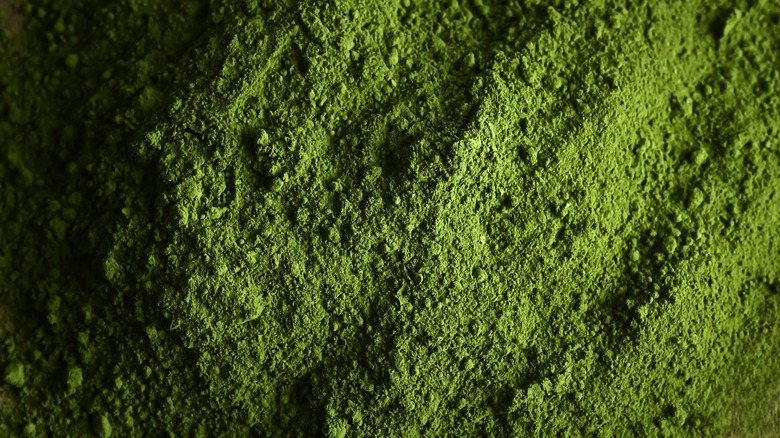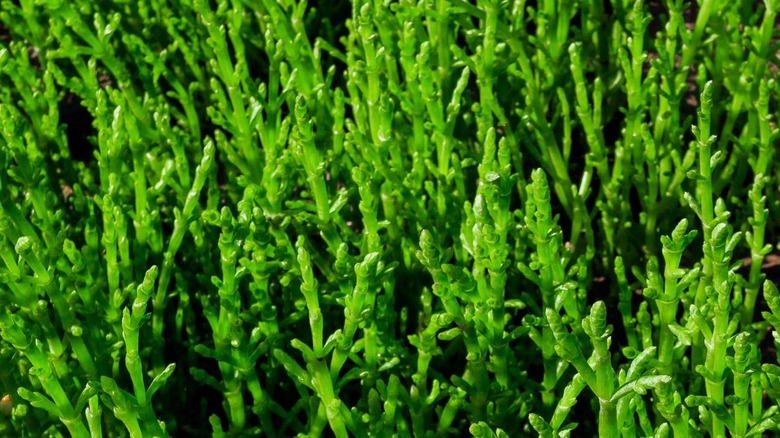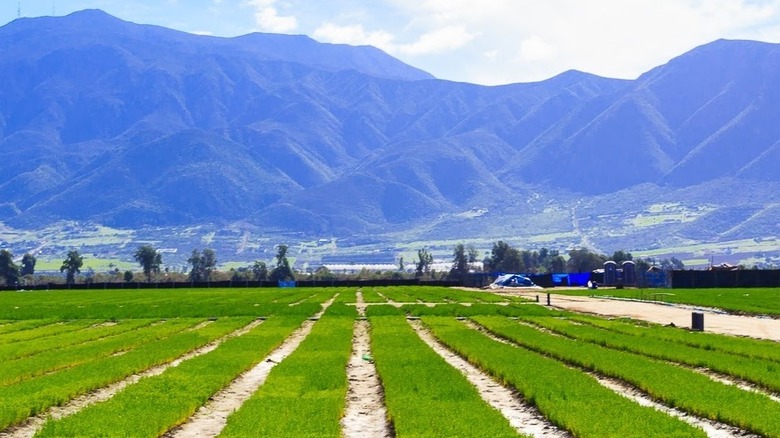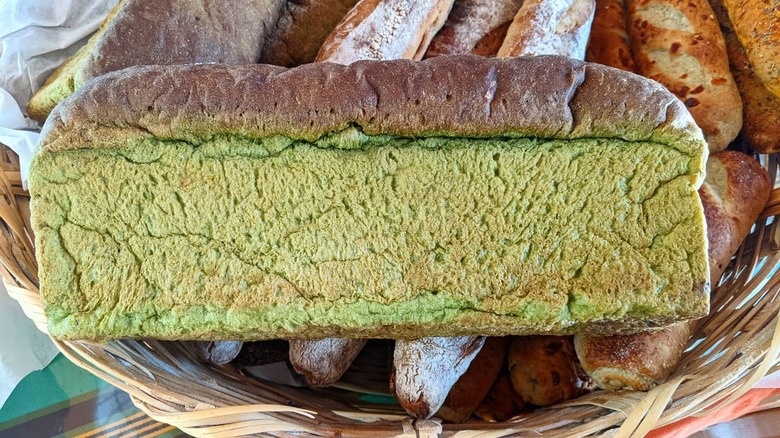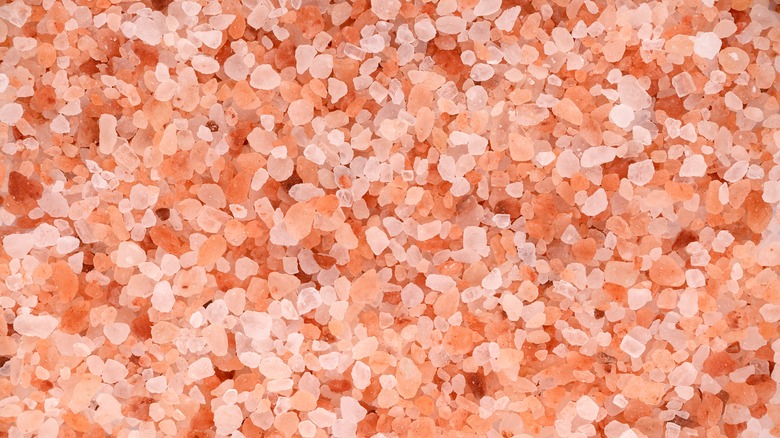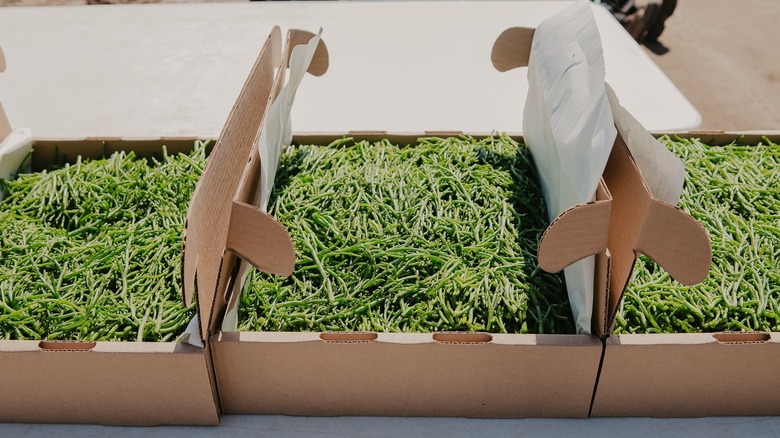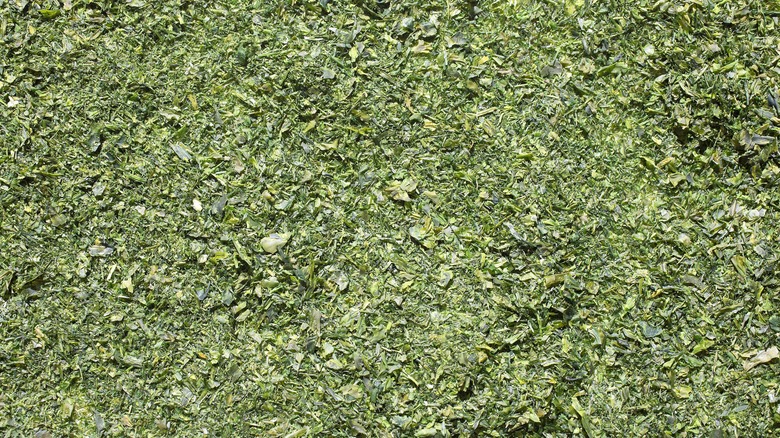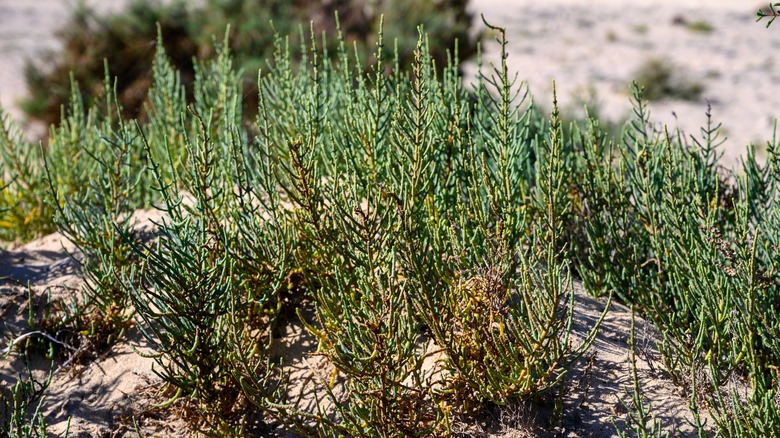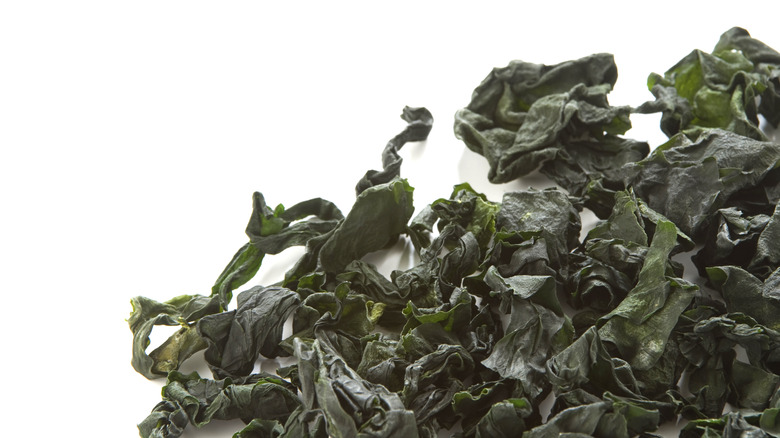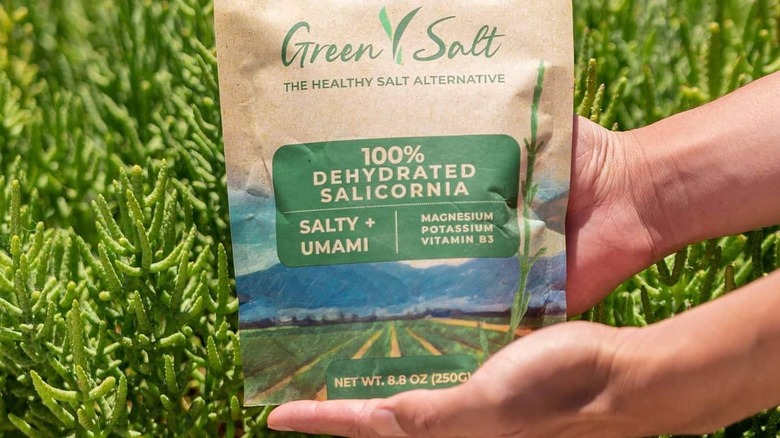Green Salt Is The Umami-Packed Salt Substitute That Cuts Back On Sodium
The salt of the earth has had its time. Thanks to serious nutritional and environmental advantages, green salt is dethroning its Himalayan counterpart (which isn't even from the Himalayas, by the way). Green is the new pink, and it's definitely worthy of its salt.
Green salt is a seasoning made from a salt-tolerant succulent or sea vegetable called Salicornia, the Latin word for salt. Every year, 25 million acres of land are lost to salinization caused by the rising sea levels of global warming. The financial implications for farmers are massive unless they can reframe the problem as an opportunity, which is exactly what the Noriega family did some 20 years ago when they decided to plant a field of Salicornia in Baja California.
Salicornia's ability to thrive in saltwater means that formerly salt-trashed farmland can continue to be used in a new way that's more sustainable for the environment than conventional crops. Salicornia doesn't require fresh water or pesticides to grow. The Noriegas sold Salicornia to restaurants worldwide but were curious about a zero-waste-type model and began dehydrating Salicornia to extend its shelf life. From there, co-founder Chris Lin tested out grinding the dry succulent into salt, creating the vibrant green salt, which enhances your dinner plate in more ways than one.
What is green salt?
Green salt isn't actually salt at all — not fundamentally, anyway. It does contain sodium, but it isn't mined from a mineral deposit or the result of evaporating seawater like most other salts. It's a greener, healthier (but no less tasty) substitute for table salt and all its variations.
Green salt is made from Salicornia, a chunky green sea vegetable dotted with tiny flowers and fruit that resembles an aquatic cross between asparagus and a tree branch. Salicornia grows naturally and in abundance in coastal regions across North America, Europe, Asia, and Africa. It changes color as it ages, moving from green to orange to pink, and, lastly, red and is also known as samphire, glasswort, sea beans, and pickleweed. Green salt is the result of dehydrating Salicornia and then grinding it into a fine green powder (texturally similar to matcha powder), which can be sprinkled on just about any food to enhance its flavor.
How is green salt made?
Green Salt is the first commercial producer of Salicornia and green salt in the world. While green salt can be made in several different ways (mainly in terms of different dehydration methods), the Noriega family produce their green salt using the following steps.
First, they farm their Salicornia organically using filtered seawater. That filtration is important because the ocean is a far cry from the standards of a commercial kitchen. In 2023, a report from the peer-reviewed research journal Plos One stated that there are more than 170 trillion plastic particles in the ocean, even before we consider other trash, oil spills, carbon emissions, and other pollutants. The Noriegas regularly test their water, soil, and resulting salt for heavy metals and detrimental microorganisms. Next, the Salicornia is dried using solar power rather than other methods that could diminish the sea vegetable's nutrient content and then ground to a fine powder.
What does green salt taste like?
Thanks to its sea vegetable origins, green salt has a delightful salty ocean tang to it with an umami accent from high levels of glutamate for good measure. It's this umami quality that has led it to be likened to the taste bud-tantalizing MSG, albeit in a naturally occurring form. Note green salt from homegarden-grown Salicornia is likely to be less salty-tasting than the foraged or commercially-produced variety as some of Salicornia's saltiness comes from its exposure to a salty environment.
Given green salt naturally contains some sodium, the ingredient will enliven taste buds in the same way that table or artisanal salt does. Add it to a dish, and you won't just get a lick of saltiness — sodium enlivens our taste buds, allowing us to perceive subtle flavors. It enhances any sweetness and takes the edge off bitterness, often transforming the balance of a dish.
How to cook with green salt
You can use green salt in exactly the same way you would table salt. Green salt can, for example, be used to draw liquid out of vegetables or meat, tenderizing, amplifying food aroma, and setting the scene for fermentation by enabling lactic acid bacteria to flourish.
Green salt comes into its own, however, when you lean into the briny notes of its flavor profile — it makes vegan seafood alternatives sing. Add a dash to lentils or chickpeas for vegan tuna, sprinkle over banana blossom for spray-kissed plant-based fish, and salt palm hearts for a plant-based seafood alternative for lobster rolls. The other two showstopping qualities of green salt are its verdant green and fine texture. Together, these characteristics make green salt a great option for baking. The fine texture combines readily with other ingredients, and the green pigment tends to give pastries, cakes, and bread a green tinge, which lends itself well to festivities such as St. Patrick's Day and Halloween without the need for artificial food dyes.
Green salt vs. pink Himalayan salt
Everything regular salt can do, green salt can do better. And yes, that includes the chunky, rosy-toned rock that is pink Himalayan salt. It brought a dash of Barbiecore to our plates before we even knew we wanted it, but when it comes to health benefits, it's "bye Barbie".
The Himalayan salt trend cruised into our kitchens on the promise that it was some sort of pink panacea but the science is lacking. The pink Himalayan hype extolls the virtues of being loaded with 84 more minerals and trace elements than table salt, but in reality, the minerals appear in too small quantities to have any positive impact on consumer health. Green salt, on the other hand, is a green-hued mineral-rich beast.
There are claims that pink Himalayan salt can spark a litany of health benefits, from improved sleep quality and libido to reducing signs of aging, but these are either unsubstantiated or related to sodium chloride consumption as a whole rather than being specific to pink Himalayan salt. If you need any further convincing of pink Himalayan salt's mere mortal status, know that it contains almost the same amount of sodium as table salt (about 40%), the overconsumption of which can lead to high blood pressure and other adverse health effects. It's really just pretty, fancy salt with a bit of misplaced street cred. Conversely, green salt contains less sodium than its pink counterpart, so it's actually healthier.
Is green salt sustainable?
All salt can be traced back to the ocean, whether harvested through cycles of saltwater evaporation to produce solar sea salt or mined from salt deposits in the ground that formed much earlier in the planet's history. In the grand scheme of the planetary impact of the mining industry, salt mining ranks low but salt purification is relatively energy-intensive.
Most of the world's pink Himalayan salt comes from the Khewra Salt Mine in Pakistan, 186 miles from the Himalayas. The harsh realities of working in mines are well known, and pink Himalayan salt is harvested by hand, but miners at Khewra seem to be treated well, according to a report from Dawn. Khewra is one of the largest in existence, but by definition, it's a finite resource. In comparison, Salicornia farming might actually aid the planet by helping to restore salt marshes, which play a vital role in sustainability, acting as a barrier against storm damage and providing a habitat for animal species.
Green salt isn't mined, and when produced via solar drying of Salicornia, it requires little energy. As a salt alternative with lower sodium, it could significantly improve human health while helping to restore the environment. It might just be one of the most ethical and sustainable salts in existence.
Health benefits of green salt
Salt may elevate a dish, but it also elevates our blood pressure. High blood pressure means an increased risk of heart disease, gastric cancer, obesity, osteoporosis, Meniere's disease, and kidney disease. In fact, one in 10 Americans die from consuming too much salt, eclipsing the adverse health effects of sugary drinks. Sodium is the blood pressure-booster in salt, and since table salt is about 40% sodium and 60% chloride, the more salt you shake onto a meal, the less healthy it becomes.
Don't get us wrong, sodium is an essential electrolyte — it balances our fluids, keeps our cells in working order, assists muscle and nerve cell function, and plays a role in transporting nutrients across cell membranes. Consume too much and the balance is tipped. The World Health Organization recommends a maximum intake of less than 2000 milligrams per day of salt for the average adult, but the global intake is over double this (4310 milligrams per day).
Varieties of green salt
Green salt is made exclusively with dehydrated Salicornia. This is unique to green salt as while there are other products on the market that share the green color, they tend to be flavored versions of salt mixes, so they aren't as nutritionally beneficial as green salt. Take green tea salt, for example. It's a blend of sea salt and matcha green tea powder. Matcha's high antioxidant level will boost the health profile of this particular green-colored salt, but the salt blend means there's still a high level of sodium, so this variation isn't on par with green salt in terms of health or how it's made. Similarly, gomashio is a green salt blend popular in Japanese macrobiotic cooking. While it uses seaweed flakes (as well as sesame seeds), these are mixed with coarse sea salt, making it completely different from green salt.
Aonori seaweed powder is essentially the same as green salt; it's just made from dried aonori seaweed rather than Salicornia. It, too, is dried and ground into a fine, green-colored salt or flake form; it's rich in magnesium and calcium and is typically used as a garnish or seasoning in Japanese cuisine or mixed into spice blends like furikake or shichimi togarashi.
How to forage or grow Salicornia
To make green salt you first need Salicornia, either foraged or grown yourself. Salicornia grows below the high tide mark in coastal areas and muddy salt marshes. When foraging, always be wary of where you're stepping to avoid falling into marsh creeks or getting caught by the incoming tide and check the ocean health in the areas you're foraging to avoid harvesting from spots with high levels of pollution. Harvest small, firm, bright green strands of Salicornia.
For Salicornia on tap (through summer, at least), you can grow it yourself indoors. You should be able to find seeds — they'll likely be called glasswort or sea asparagus — through specialty nurseries. Sow seeds in autumn and they'll begin germinating in spring. Raise in full sun (at least six hours of sun per day) in temperatures above 50 degrees Fahrenheit in well-draining soil made from one part sand and four parts soil topped with compost for extra nutrients. Water sparingly, replicating coastal conditions by mixing a teaspoon of sea salt into a gallon of water.
How to make green salt
Once you have your Salicornia, you need to prepare it for drying which you can do by rinsing to remove any impurities (especially important if using foraged Salicornia) then cut into short strands. There are several different options for drying — you can lay strands in direct sunlight, place them in an oven set at 150 F with the door slightly ajar, use a dehydrator, or hang them in a well-ventilated area for air-drying as you might do with herbs or flowers. Pulverize the dried sea vegetable in a coffee bean grinder, spice grinder, Vitamix, or mortar and pestle if you're feeling especially motivated, then store in an airtight container until ready to use.
Green salt can last for a long while, which is useful given that you're likely to use only a pinch at a time. However, making it yourself is an energy and time-intensive process so it's worth making in bulk. For that, you'll need a huge amount of Salicornia as, like mushrooms and spinach, the yield is low — you'll get less than 1/4 cup of green salt from 12 ounces of Salicornia. Green salt's green pigment can fade over time, but this can be delayed by being stored in an airtight container or bag in the freezer.
Where to buy green salt and how to store it
If you don't have time to forage or grow and harvest your own Salicornia, the most efficient way of acquiring green salt is to order it online straight from the source. Green Salt, the Noriega family's business, sells a two bag bundle of 100% dehydrated Salicornia (7.05 ounces per bag, the equivalent of 700 pinches of green salt) for $44, and it'll last for three years in a cool, dry spot. They also produce an all-purpose green salt seasoning, which is a blend of dried Salicornia mixed with pepper, garlic, onion, paprika, coriander, basil, lemon, and ginger. You can order a 2-ounce glass container for $10. Free samples are available on the company's website.
If you relish incorporating this sea vegetable into your cooking, you'll probably want to explore other delicious seaweeds. Curious? Here are 10 types of seaweed and how to eat them.
